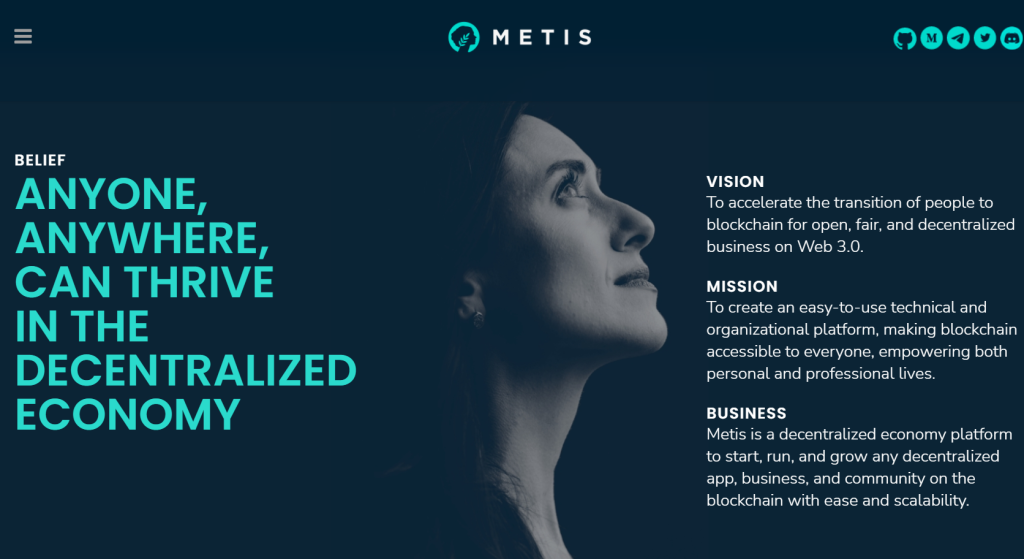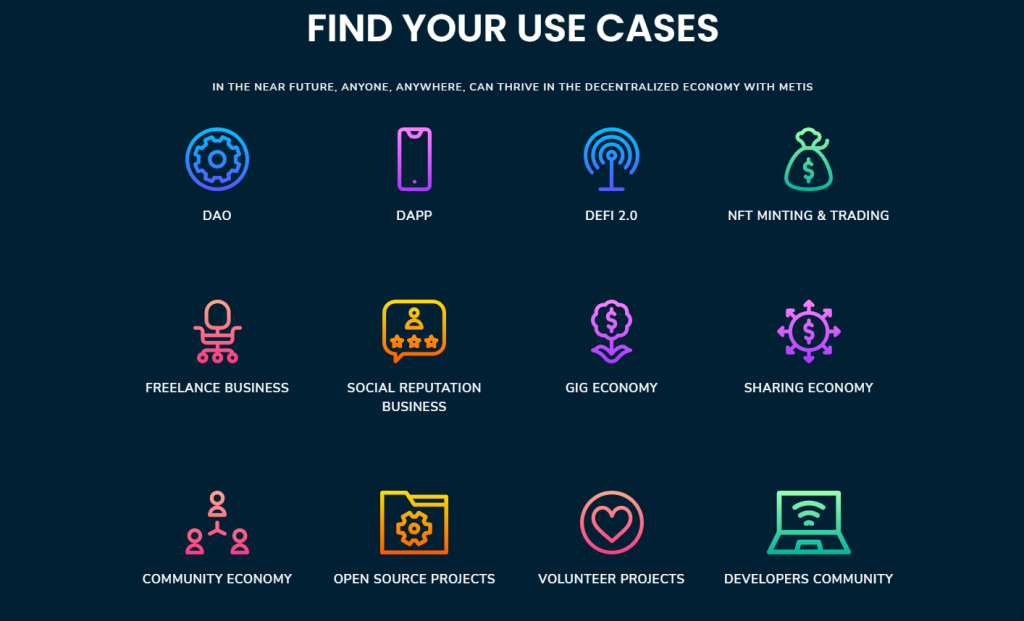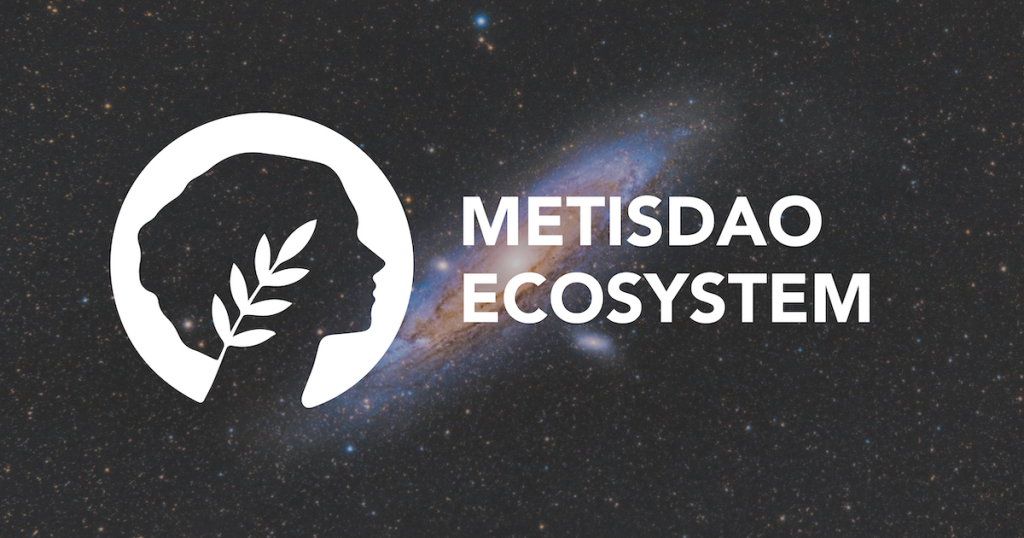In the previous article, we took a look at the technical features underlying Metis’ platform. In this article, we seek to understand
- Metis’ aims for its platform
- The current applications in the Metis ecosystem
- Its plans to facilitate further development on its mainnet, Andromeda.
(Also Read: What Is MetisDAO ($METIS)? Its Underlying Technology And What Makes It Better Than Other L1s And L2s)
Project aims
Officially, Metis’ vision is to accelerate the transition of people to blockchain for open, fair, and decentralised business on Web3.0.

To achieve its vision, Metis has built its platform with the primary aim of providing infrastructural support to Web3.0 applications. This is to allow anyone, regardless of blockchain coding experience, to deploy their applications on the blockchain with relative ease.
But besides the usual decentralised applications such as AMMs, NFT marketplaces and games, Metis has a particular fetish for DAOs. And not just DAOs, but specifically DACs.
What are DACs?
DAC is short for Decentralised Autonomous Company.
Before diving into what DACs are, let’s break down the notion of a Decentralised Autonomous Organisation (DAO) first.
A DAO is an organisation where there is no single person or entity in charge of the decision making process. Instead, the DAO simply follows a fixed set of rules (smart contracts that are encoded transparently), hence the term ‘autonomous’.
Furthermore, these rules are voted by members of the DAO (those who hold the DAO’s governance token). This gives everyone a say in the decision-making process, hence the term ‘decentralised’.

Overall, DAOs are construed as the Operating System of social communities. They offer a technical layer to provide global and decentralised collaboration between individuals without having to trust third parties.
However, most DAOs are limited in function as they only deal with voting/governance. As a result, DAOs lack the crucial corporate capabilities to support full-fledged businesses.
And this is where DACs come into play.
In essence, DACs are like DAOs, but with the additional ability to scale horizontally. This is because DACs have in-built features to implement HR, payroll, ERP, CRM, corporate management systems, marketing campaigns etc.
With these functionalities that enable richer interactions, DACs can onboard fully functioning companies onto the blockchain, offering a level of infrastructural support equivalent to that of Web2.0 companies, all while remaining decentralised.
The Total Addressable Market of this is enormous, and here are some use cases:

With that being said, let’s explore some of the applications that have already gone live on Metis’ Mainnet, Andromeda.
DeFi
Netswap is the primary DEX on Metis Andromeda and its AMM model is the same as Uniswap’s. But unlike Uniswap on Ethereum, Netswap’s deployment on L2 implies that transactions are low-cost, speedy and scalable.
Swaps went live over a month ago and the liquidity mining programme just commenced on 9 January, giving Netswap a current TVL of nearly $300 million.
Besides the typical services that most DEXes offer, Netswap plans to embrace innovation by releasing more innovative functions.
For instance, Netswap plans to release a Launchpad to help projects raise funds for development. They also intend to integrate a built-in leverage swap function (up to 5x leverage) to accommodate degen traders. All these implementations are expected within a month’s time!
Netswap never stops building…
— Netswap (@netswapofficial) January 9, 2022
🛸2022 Q1 ROADMAP:
Jan 9th – Opening of Liquidity Mining Program
End of Jan to Feb – Launchpad; Leverage Swap; Partnership with BinaryDAO
Mar – Governance Module; Partnership with a #StableCoin project and #GameFi project
✨Stay Tuned!✨ pic.twitter.com/55sH8rDaoP
Tethys and Standard Protocol are 2 other AMMs that have been deployed on Andromeda. And to auto-compound your gains on these AMMs, dapps like Beefy Finance and Pickle Finance have also launched on Metis Andromeda.
There is also a money market protocol, Agora, that has gone live, albeit with disappointing yields. On this note, DeFi strategies will be covered in my subsequent articles.
NFTs and the metaverse
Metacraft is an NFT creation, crowdfunding and collaboration platform. Its NFT marketplace is embracing the cross-chain thesis and it is integrated with Binance Smart Chain and Polygon.
Incentive programme
With the recent launch of these new projects, Metis Andromeda’s TVL went up to over US$500 million.
To further catalyse TVL, it is apparent that a larger and more diverse ecosystem of dynamic blockchain projects is needed. In response, Metis has launched a US$100 million fund (Genesi) to support projects that join its ecosystem.
According to Metis, Genesi will be allocated across a wide range of high-potential projects in all major crypto verticals including DeFi, gaming and DAOs.
This incentive programme is meant to help Metis gain traction against other L1s like Avalanche and Harmony.
Genesi also enables Metis’ first-mover advantage in the L2 space as Arbitrum and Optimism, the 2 leaders in L2 solutions, have yet to deploy funds in order to bootstrap activity on their network.
Hackathon
Metis has also just concluded their hackathon, which brings in hardworking developers and engineers to actively build applications on Metis. Evidently, we can expect an incoming flood of TVL once these projects launch on Andromeda.
Metis Builder Mining Programme
This is perhaps the most interesting strategy I’ve ever come across.
Essentially, to build Metis’ Metaverse (the Metisverse), Metis believes its ecosystem partners play an important role and has implemented a scheme whereby builders can benefit each other.
This scheme, known as the Builder Mining Programme, will incentivise all ecosystem partners to build on Metis Andromeda.
How this works is that every month, Metis will calculate the total amount of gas fees collected. From this amount, 30% will be distributed back to the individual projects, proportional to the project’s transaction volume.
To illustrate what this means, assume there are 1000 METIS tokens collected from gas fees for the month of January. 30% of this, or 300 METIS tokens, will be distributed to the projects.
Assume Project A’s transaction volume accounts for 10% of all transactions on Andromeda. Project A will hence receive 30 METIS tokens as Builder Mining rewards.
A $METIS feature that will enable top-quality partnerships: Builder Mining.
— Metis (@MetisDAO) January 5, 2022
On our Layer 2 Andromeda network, gas fees are paid in $METIS (like $ETH/Ethereum).
30% of the $METIS we collect in gas fees get KICKED BACK TO DAPPS ON OUR NETWORK.
Read on!https://t.co/dyFmgRjT5F
Evaluating the Builder Mining Programme
The rationale behind this programme is as such: The more transactions a dapp makes, the greater the contribution it is making to the whole ecosystem. As such, the dapp will get compensated with more rewards.
The implication of this programme is as such: Since projects are rewarded based on the volume of transactions generated, builders are more incentivised to ensure the viability of their dapp. This is because if the project is good and has garnered solid traction, there will be a higher volume of transactions.
If all projects adopt this mindset, this will lead to more gas collected by Metis and more rewards distributed to the project. This will then incentivise other applications to build on Metis, reinforcing a virtuous cycle that facilitates on-chain development.
Additionally, from a user perspective, this somewhat serves as a Quality Control filter as the projects that build on Metis should have a reasonable standard of quality.
Conclusion
Overall, I believe Metis is well on its way to achieving its vision. With a solid management team that has never failed to execute and a potential pipeline of projects waiting to launch, the future is bright for Metis.
If the previous article on Metis’ technical features and this article on Metis’ project aims have solidified your investment thesis in Metis, do stay tuned for my next article which will introduce the $METIS token and where/how to buy it!
Featured Image Credit:
Also Read: What Is MetisDAO ($METIS)? Its Underlying Technology And What Makes It Better Than Other L1s And L2s



































